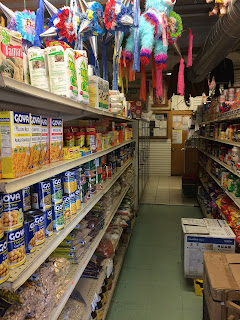Each spring, Philly’s
Italian Market sets up a rollicking two-day block party. The music is loud, the
people-watching spectacular, and the food plentiful.
In search of lunch, one might walk the eight-block festival and consider a
porchetta sandwich or ravioli, barbacoa tacos or tamales, skewered grilled
quail or papaya salad. (‘Italian Market’ is sort of a misnomer these days; in
the 1980s and 90s, immigrants populated the historically Italian neighborhood
with Vietnamese, Cambodian and Mexican restaurants.)
Natalie and Hope,
first-timers at the festival, were strategic: “We sat for a while and watched
other people eat, and then decided
what to eat,” Natalie said.
They chose Dibruno
Brothers’ spinach arancini and chicken meatball hoagie, and made a tentative
plan to return for Esposito’s massive porchetta sandwich. At a table set up a
comfortable distance from the throngs on 9th street, they had a prime
view of the festival’s main attraction: the Greased Pole Competition.
It’s an old, offbeat
Philly tradition: people attempt to shinny up lard-sheened pole to reach sharp
provolone, sausage, gift cards and cash hanging from the top. Some competitors
form teams that meet to practice throughout the year; others join hodgepodge groups
recruited by the MC on the day of the festival. A crowd assembles around the
piazza on 9th and Montrose Streets to cheer and fling their shirts
to the top climbers to use as grease rags.
No joke.
“That’s the way…”
“His hands are all up on
his butt!”
“His arms are going to
give out!”
Natalie and Hope scrutinized
a team of six – two at the base of the pole gripping each other’s forearms,
two climbing to stand on their shoulders, and two steadying ankles and boosting butts with
both arms.
“We’ve been watching this
for a while,” Natalie said. “It’s the same group – they keep getting a little
higher.” But the dangling prizes still hung 30 feet in the air, untouched. The
MC, sporting a #GuidoLive t-shirt, tried to cajole a few more volunteers from
the crowd.
“I think it’s the Breathalyzer,”
Hope said. She suspected that passing the BAC test – a policy put into place
two years ago – had deterred many.
Natalie laughed. “When I
met up with her this morning, she had a pineapple with rum in it.” Blue Corn
Restaurant serves piña coladas in hollowed pineapples.
“An excellent breakfast,”
Hope said.
It was her day off. She’d
spent the previous week thinning fruit in the rain at North Star Orchards, a
farm and orchard in Cochranville known for developing stunning apple varieties.
“Apparently the fruit doesn’t taste good if you leave all the clusters,” she
told me. Growers typically pluck the diseased and undersized fruit to allow the
tree to send its resources to fewer choice specimens.
Hope started working at
the farm this spring. Everyday at noon, the entire crew eats lunch together. Hope
forages for greens and mushrooms in the woods near the farm to incorporate into
her meals.
She’s an urban forager,
too.
“There were a bunch of
pork skewers in the trash can that she wouldn’t let me eat,” Hope said, leather
tassel earrings swishing as she gave Natalie a look.
“I figured there was a
reason they were in the trash can.” Natalie says.
Natalie is a front of
house operations manager for catering at UPenn. She typically eats lunch with
colleagues at Houston Hall. “When we don’t have time it’s a standing lunch with
returned hors d’oeuvres from whatever event we’re at,” she said. “It’s the one perk
of working in food service – I never have to pay for lunch.”
The two might splurge on a
few more lunch bites at the festival, and stick around to watch a dozen pumped
bros armed with bath towels storm the piazza.
“Let’s go, let’s go, let’s go!”
The team built a clenched, grunting tower around
the pole and in fewer than five minutes, their top climber was throwing
sausages to the ground in triumph.

















